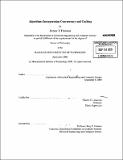Algorithms incorporating concurrency and caching
Author(s)
Fineman, Jeremy T
DownloadFull printable version (29.67Mb)
Other Contributors
Massachusetts Institute of Technology. Dept. of Electrical Engineering and Computer Science.
Advisor
Charles E. Leiserson.
Terms of use
Metadata
Show full item recordAbstract
This thesis describes provably good algorithms for modern large-scale computer systems, including today's multicores. Designing efficient algorithms for these systems involves overcoming many challenges, including concurrency (dealing with parallel accesses to the same data) and caching (achieving good memory performance.) This thesis includes two parallel algorithms that focus on testing for atomicity violations in a parallel fork-join program. These algorithms augment a parallel program with a data structure that answers queries about the program's structure, on the fly. Specifically, one data structure, called SP-ordered-bags, maintains the series-parallel relationships among threads, which is vital for uncovering race conditions (bugs) in the program. Another data structure, called XConflict, aids in detecting conflicts in a transactional-memory system with nested parallel transactions. For a program with work T and span To, maintaining either data structure adds an overhead of PT, to the running time of the parallel program when executed on P processors using an efficient scheduler, yielding a total runtime of O(T1/P + PTo). For each of these data structures, queries can be answered in 0(1) time. This thesis also introduces the compressed sparse rows (CSB) storage format for sparse matrices, which allows both Ax and ATx to be computed efficiently in parallel, where A is an n x n sparse matrix with nnz > n nonzeros and x is a dense n-vector. The parallel multiplication algorithm uses e(nnz) work and ... span, yielding a parallelism of ... , which is amply high for virtually any large matrix. (cont.) Also addressing concurrency, this thesis considers two scheduling problems. The first scheduling problem, motivated by transactional memory, considers randomized backoff when jobs have different lengths. I give an analysis showing that binary exponential backoff achieves makespan V2e(6v 1- i ) with high probability, where V is the total length of all n contending jobs. This bound is significantly larger than when jobs are all the same size. A variant of exponential backoff, however, achieves makespan of ... with high probability. I also present the size-hashed backoff protocol, specifically designed for jobs having different lengths, that achieves makespan ... with high probability. The second scheduling problem considers scheduling n unit-length jobs on m unrelated machines, where each job may fail probabilistically. Specifically, an input consists of a set of n jobs, a directed acyclic graph G describing the precedence constraints among jobs, and a failure probability qij for each job j and machine i. The goal is to find a schedule that minimizes the expected makespan. I give an O(log log(min {m, n}))-approximation for the case of independent jobs (when there are no precedence constraints) and an O(log(n + m) log log(min {m, n}))-approximation algorithm when precedence constraints form disjoint chains. This chain algorithm can be extended into one that supports precedence constraints that are trees, which worsens the approximation by another log(n) factor. To address caching, this thesis includes several new variants of cache-oblivious dynamic dictionaries. (cont.) A cache-oblivious dictionary fills the same niche as a classic B-tree, but it does so without tuning for particular memory parameters. Thus, cache-oblivious dictionaries optimize for all levels of a multilevel hierarchy and are more portable than traditional B-trees. I describe how to add concurrency to several previously existing cache-oblivious dictionaries. I also describe two new data structures that achieve significantly cheaper insertions with a small overhead on searches. The cache-oblivious lookahead array (COLA) supports insertions/deletions and searches in O((1/B) log N) and O(log N) memory transfers, respectively, where B is the block size, M is the memory size, and N is the number of elements in the data structure. The xDict supports these operations in O((1/1B E1-) logB(N/M)) and O((1/)0logB(N/M)) memory transfers, respectively, where 0 < E < 1 is a tunable parameter. Also on caching, this thesis answers the question: what is the worst possible page-replacement strategy? The goal of this whimsical chapter is to devise an online strategy that achieves the highest possible fraction of page faults / cache misses as compared to the worst offline strategy. I show that there is no deterministic strategy that is competitive with the worst offline. I also give a randomized strategy based on the most recently used heuristic and show that it is the worst possible pagereplacement policy. On a more serious note, I also show that direct mapping is, in some sense, a worst possible page-replacement policy. Finally, this thesis includes a new algorithm, following a new approach, for the problem of maintaining a topological ordering of a dag as edges are dynamically inserted. (cont.) The main result included here is an O(n2 log n) algorithm for maintaining a topological ordering in the presence of up to m < n(n - 1)/2 edge insertions. In contrast, the previously best algorithm has a total running time of O(min { m3/ 2, n5/2 }). Although these algorithms are not parallel and do not exhibit particularly good locality, some of the data structural techniques employed in my solution are similar to others in this thesis.
Description
Thesis (Ph. D.)--Massachusetts Institute of Technology, Dept. of Electrical Engineering and Computer Science, 2009. Cataloged from PDF version of thesis. Includes bibliographical references (p. 189-203).
Date issued
2009Department
Massachusetts Institute of Technology. Department of Electrical Engineering and Computer SciencePublisher
Massachusetts Institute of Technology
Keywords
Electrical Engineering and Computer Science.